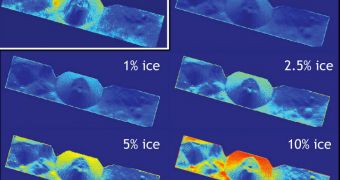NASA scientists say that their latest study of permanently-shadowed craters near the lunar south pole has revealed a location where water-ice may exist in abundance. They say that between 5 and 10 percent of the materials making up Shackleton crater's walls could be accounted for by ice.
The findings were made using the Mini-RF radar instrument aboard the NASA Lunar Reconnaissance Orbiter (LRO). The mission launched towards the Moon aboard an Atlas V delivery system, on June 18, 2009, from the Cape Canaveral Air Force Station's Space Launch Complex 41.
The Miniature Radio Frequency radar was the first instrument of its kind to demonstrate a new type of synthetic aperture radar technology, as well as to showcase new communications technologies. In addition to Mini-RF, the orbiter carries a suite of six scientific instruments.
Shortly after it launched, LRO was able to confirm the existence of water-ice at the lunar south pole, by investigating the ejecta plume produced when the Lunar Crater Observation and Sensing Satellite (LCROSS) dropped a spent Centaurus upper stage into Cabeus Crater.
After scientists confirmed that the material exists on the Moon, LRO began a campaign to investigate the locations where higher concentrations of water-ice are present. If people are to live on the Moon, then they will need access to this previous resource.
Water-ice can be used to manufacture oxygen for breathing, hydrogen fuel for rocket, and water.
Upon investigating Shackleton crater, experts from Boston University Center for Remote Sensing and the NASA Goddard Space Flight Center (GSFC), in Greenbelt, Maryland, found that 5 to 10 percent of the materials making up its wall was water-ice.
“These terrific results from the Mini-RF team contribute to the evolving story of water on the Moon. Several of the instruments on LRO have made unique contributions to this story, but only the radar penetrates beneath the surface to look for signatures of blocky ice deposits,” says John Keller.
The expert is the deputy project scientist for the LRO mission at Goddard. He says that Shackleton crater is currently classified as a high-priority science target for future explorations and studies. Details of the Mini-RF results appear in the latest issue of the journal Geophysical Research Letters.
“The interior of this crater lies in permanent shadow and is a 'cold trap' – a place cold enough to permit ice to accumulate. The radar results are consistent with the interior of Shackleton containing a few percent ice mixed into the dry lunar soil,” says Ben Bussey.
The expert is the principal investigator for the Mini-RF instrument, and is based at the Johns Hopkins University (JHU) Applied Physics Laboratory (APL), in Laurel, Maryland.

 14 DAY TRIAL //
14 DAY TRIAL //